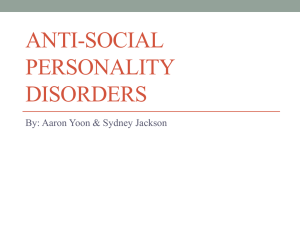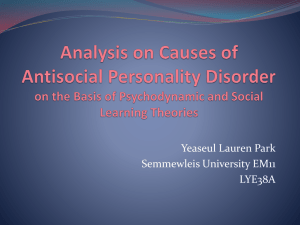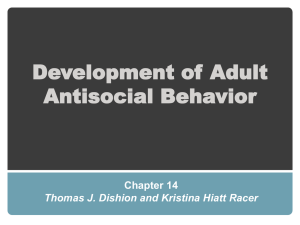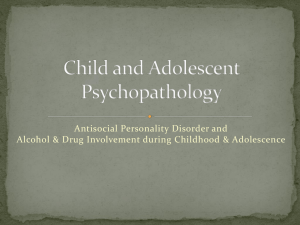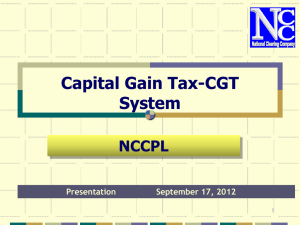Using the CANTAB to investigate cognitive deficits in ASPD
advertisement
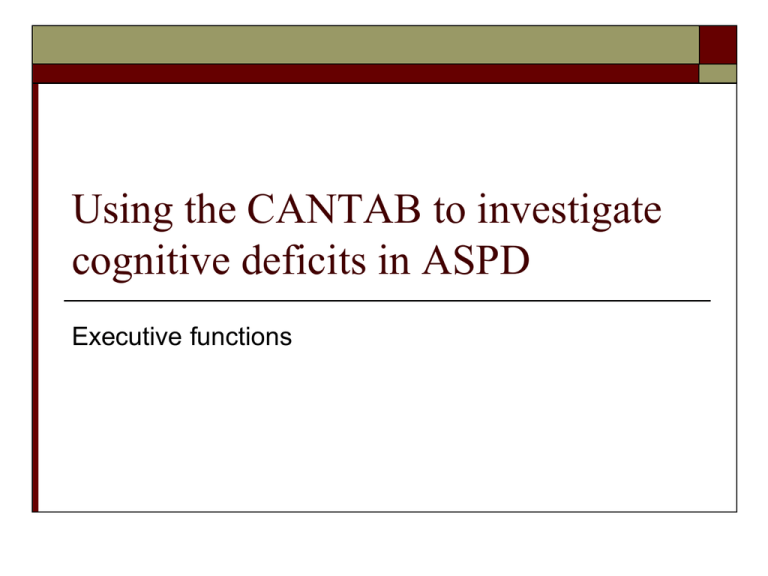
Using the CANTAB to investigate cognitive deficits in ASPD Executive functions ASPD Prevalent 1-1.3% in GP 47% in prisons Poor prognosis High societal costs Resistance to treatment Cognitive functions (Lezak et al., 2004) Executive Volition Planning Purposive action Self-regulation Effective performance Planning & Effective performance Planning ToL: Barkataki et al. (2005) SOC: Dolan & Park (2002) n-back: Kumari et al. (2006) Porteus mazes: Stevens et al. (2003) Effective performance C/W Stroop: Barkataki et al. (2005) Self-regulation (1) Productivity COWAT: Stevens et al. (2003) Motor regulation Response inhibition Go/NoGo (Barkataki et al., 2008; Dolan & Park, 2002; Howard et al., 1997; Völlm et al., 2010) Response delay (Swann et al., 2009) Self-regulation (2) Cognitive flexibility Response reversal Attentional set-shifting IED: Dolan & Park (2002) WCST: Barkataki et al. (2005) & Stevens et al. (2003) IED: Dolan & Park (2002) Alternating stimuli TMT-B: Stevens et al. (2003) METHOD Participants 102 male inpatients at the PDS, Arnold Lodge Regional Secure Unit 17 excluded: ASPD n=52; non-ASPD n=33 IQ<70 History of MMI & TBI AGN & CGT 20 male ancillary staff IQ>70 Free from MMI & TBI Free from current/past substance abuse Measures Patients: ASPD vs. non-ASPD SADS-L/SCID-I:CV IPDE WAIS-III Healthy controls MINI Quick Test IPDE Screening questionnaire Interview if necessary The Executive CANTAB Planning Decision-making Response control Cognitive flexibility Planning: Stockings of Cambridge (SOC) Perfect solutions Mean moves to solution Executive CANTAB Planning – SOC Decision-making Decision-making: Cambridge Gambling Task (CGT) Quality of decisionmaking Overall proportion bet Executive Planning – SOC Decision-making – CGT Response control Motor/response control: Inhibition Affective Go/NoGo (AGN) # Commission errors Executive Planning – SOC Decision-making – CGT Motor/response control – AGN Cognitive flexibility Cognitive flexibility: Intra/extra-dimensional set-shifting (IED) Cognitive flexibility: Attentional set-shifting (IED) # Errors Reversal EDS The Executive CANTAB Planning – SOC Decision-making – CGT Motor/response control – AGN & IED Cognitive flexibility – IED RESULTS Sample characteristics Groups matched on: IQ Basic education (yrs) Number of PDs other than ASPD Mood stabilisers Age: non-ASPD>ASPD SRD: ASPD>non-ASPD Antidepressants: non-ASPD>ASPD Planning (SOC): Perfect solutions ASPD & N-ASPD<HC but not different compared to each other. 12 10 Perfect solutions 8 6 4 2 0 ASPD N-ASPD Group HC Planning (SOC): Mean moves ASPD & N-ASPD<HC but not different compared to each other Moves 6.8 5.8 4.8 ASPD 3.8 N-ASPD 2.8 HC 1.8 2 3 4 Problem difficulty (minimum moves to solution) 5 Decision-making (CGT): Quality of decision-making ASPD & N-ASPD<HC Group x increment interaction Decision-making 1 0.95 0.9 ASPD 0.85 N-ASPD 0.8 HC 0.75 Ascending Descending Bet increment Decision-making (CGT): Quality of decision-making Decision-making ASPD & N-ASPD<HC Group x odds interaction 1 0.95 0.9 0.85 0.8 0.75 0.7 0.65 ASPD N-ASPD HC 9:1 8:2 7:3 Betting odds 6:4 Response inhibition (AGN): Commission errors ASPD>HC 14 Number of errors 12 10 8 6 4 2 0 ASPD N-ASPD Group HC Response reversal & Attentional set-shifting (IED): # errors Reversal: ASPD>N-ASPD & HC EDS: ASPD>HC 16 14 12 Errors 10 ASPD 8 6 N-ASPD 4 HC 2 0 Reversal EDS Error type Results summary Non-characteristic deficits: Planning Broadly agreed with Dolan & Park (2002) Quality of decision-making Characteristic deficits (?): Response inhibition Response reversal & Attentional set-shifting Some agreement with Dolan & Park (2002) Limitations Unable to place N-ASPD Effect of substance abuse Confounding of offending Limited power for AGN and particularly CGT THANK YOU
